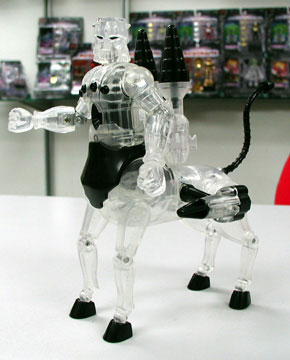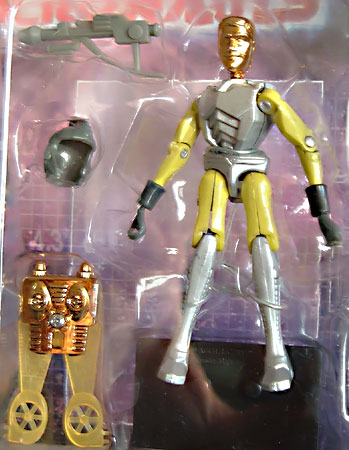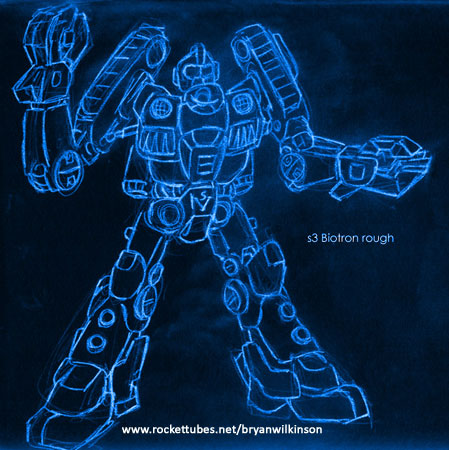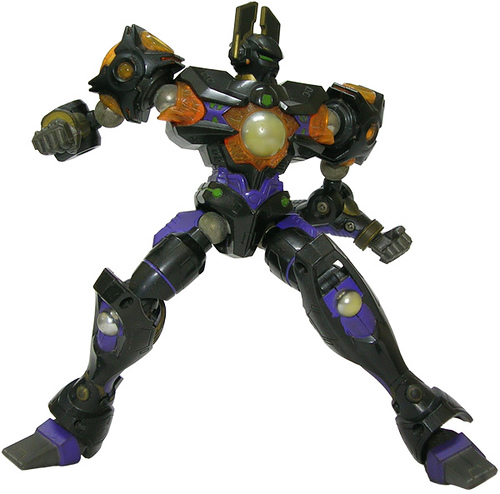Fanmode interview: Bryan Wilkinson (part 4)
Long-time Micronauts and Microman fan, Bryan “MicroBry” Wilkinson, is one of the select few who’ve made the transition from toy fan to toy designer. His website was one of the earliest to draw attention to Transformers’ (then) little-known origins, and he was given the opportunity to work on Palisades’ Micronauts revival in 2002. As Transformers celebrates its 25th. anniversary and Microman celebrates its 35th., we thought it only appropriate to ask him about Micronauts, Microman, Transformers, fandom, and making the transition from consumer to creator.
(Due to its length, the interview will be presented in several parts. Parts one, two and three were published earlier.)
When did it become clear the Palisades Micronauts line was seriously flawed?
It wasn’t clear at first if the early reports of bad product were just a fluke or not so Palisades had no clue just how extensive the damage to the line was until well after it was far too late to recall the product.
We started getting the first shots back from the newly commissioned factory in China in June 2002, and they looked fantastic. Those of us who have owned preproduction samples can vouch that the initial hand-made prototypes were of excellent quality that matched or even possibly outdid their originals.
Furthermore, Ken Lilly (head of Palisades’ product development then) went to China in September, saw the production floor and was given a number of samples. He sent back photos which included a nice, sturdy clear-cast Baron Karza that not only could form the centaur form properly but even hold the classic “rearing up” pose that the original toy could do so effortlessly. (The Karza that shipped could not form the centaur mode without serious modification and even then didn’t fit together this precisely.) The stuff was pretty solid and just about to enter full production.

Micronauts copyright © 2002 AGE, Takara, licensed to Palisades Toys.
Photo by Ken Lilly for Palisades
What none of us knew until much later was that Ken had been given a total dog and pony show by a dishonest company acting as Palisades’ middleman responsible for subcontracting the factory (this was very similar to what Patrick Calello experienced).
A significant percentage of the commission was paid to the middleman at this point, and the other portion was to be paid after contract fulfilment. This middleman apparently had no intention of ever collecting the rest. Instead, their firm kept most of the money and farmed out the production to another facility to do it for a fraction of the cost and with no quality control.
Not only was the Micronauts line impacted, but other lines assigned to the factory at the time, such as part of the early Muppets series, suffered though not as heavily.
The other problem was the U.S. dock workers had a union strike in October that brought all scheduled import shipments down to a crawl. The Micronauts line did not come out until a good month or two after the planned release schedule, and the overdue cargo went directly to the distribution centers without Palisades getting any of the first shipments.
I got my sample product before Palisades (yet after many in the fan community), and I was appalled and pained to see all our hard work on the line turn out so badly. At this point, Ken still was unsure if the amount of bad product was being exaggerated (as fans can be awfully picky folks and this was still limited to a few “early bird” reports), so I did my best to make it clear how extensive the problem was and the scope of how many errors, mispackaged and defective parts were in the two full cases of product I got. He was pretty stunned. Later, when he finally got Palisades’ samples, his own remark was to the effect that he couldn’t believe how tolerant we’d been up to this point as fans as he would be ashamed to put these on his shelf, let alone with his name attached to it. (Palisades always credited its staff and contributors on its packages.)
The company that had acted as the middleman never got the rest of their money, of course, and conveniently vanished when pursued.

Copyright © Bryan Wilkinson. Used with permission.
Micronauts copyright © 2002 AGE, Takara, licensed to Palisades Toys.
What steps were taken?
From what I remember, Palisades acknowledged the problem as soon as they were aware of it. Being a small company and already over-budget on the project, Palisades couldn’t afford to do much more than attempt to replace any toys that were returned directly to them. It was all handled by one person due to the small size of their team.
The problem was exacerbated by online exclusives, which were sent out directly from Palisades’ own warehouse. Palisades tried to limit shipments to toys that weren’t visibly damaged in-package, but they were still stuck with sending out toys which were at best badly made and likely to either have unspotted errors or develop stress cracks afterwards.
This might have been their worst mistake from a public relations point of view, as some felt that this indicated they were trying to still push and mark up known defective product.
Why did Palisades choose to continue with Series 2?
Palisades could have just cut their losses there and moved on — so much money was lost on this project that it would be impossible to recover it even if Series 2 by some miracle actually sold well — but there was some professional pride at stake here and a reputation to try to salvage. So they soldiered on with not just the already-planned Series 2, but had another factory fix the tooling from Series 1.
(The tooling and molds were severely and maliciously sabotaged, requiring repair and retooling yet again. Some parts, such as the figure hands and cuffs, had to be pretty much retooled from scratch.)
Palisades also did a special release, Series 1.5, with the quality the Series 1 toys were intended to have. The new factory did a great job. There were a few minor bungles still, but we were watching this effort like hawks now and for the most part everything came out as planned.
We did find out much later there was a misused materials error in the 1.5 release which caused the rubber tube gasket to slowly fuse with the plastic. These tubes were not as specified and the pre-production samples did not have the issue. Because the problem didn’t appear immediately, it wasn’t noticed until long after release. The Series 1.5 Acroyear was unaffected by this issue and is probably the best-made toy in the whole line.
Series 2 did not have the issue at all and I think did us proud. It really was how Series 1 should have turned out. This was a really happy moment for me, because my earliest work on the project was on making the accessories for Series 2 over a year before. By sheer luck I was the first person to receive the final product, so it was one of the real bright moments getting to tell both Palisades and the fan community first that things were going to be better this time.
Alas, it was also to be the last time …

Copyright © Bryan Wilkinson. Used with permission.
Micronauts copyright © 2002 AGE, Takara, licensed to Palisades Toys.
What happened to the proposed Series 3 featuring original designs?
We were unsurprised at this point that the retailers and potential exclusive vendors were uninterested in more Micronauts product. The damage was done and also had the additional bad side effect of reinforcing the general lingering impression that Micronauts was no longer a worthwhile product, especially without any big media tie-in or large fanbase. Palisades put out Series 2 as a smaller run than some of their exclusives, and simply lost even more money on this last attempt to at least save some face with the fans.
Ken worked with us to get a group of artist consultants together to brainstorm an all-new third series of figures in a last-ditch effort to try to keep management interested in salvaging the series, but to no avail in the end. Micronauts was now an albatross for Palisades, their biggest financial loss ever.
Does Micronauts, as a toyline, have a future?
I believe it does, or at least it should. However, in order for it to succeed, it really ought to have Takara Tomy on board, preferably along with a large U.S. toy company such as Hasbro or Mattel. A Micronauts without Takara Tomy could work in the right hands, but is otherwise more likely to be mishandled.
(Takara did magic with the 1999 Microman MagnePowers toys. These things were built to take a beating, were fun to play with, and extremely interchangeable. While the recent magnetic toy lawsuits might pose some concern, I have little doubt that a strong toyline like MagnePowers would do well were it marketed today, were Takara Tomy to focus on creating more of this kind of high quality toy product.)

Micronauts will not have a future if the battle over the property continues endlessly, though. One way or another, this decades-old fight needs to conclude before any headway can be made at all. It’s understandable that Takara Tomy would want the Micronauts brand name before marketing Microman product abroad in Western countries, but I think many would be just as happy if they dropped it and just sold them as Microman or even under a new name.
With that said, according to the US Patent and Trademark Office, Takara Tomy has assigned all trademark rights to Micronauts and related trademarks (such as Hornetroid and even the fan-named Chromantron) to Abrams Gentile Entertainment as of June 4th. I’m not sure what to make of the little information available now, but perhaps with the current economic situation, Takara Tomy has decided to give up the fight (which was still ongoing as recently as March).
AGE may now own the Micronauts trademarks, but they don’t own the original toy likenesses. If Takara Tomy is not participating, then AGE still has a lot of work to do, I imagine. The big hurdle for AGE is that Micronauts aren’t well-remembered, and those who do remember them tend to associate it with either the Marvel comic characters (who are unlikely to be a part of a new line though it would be an asset if they were) or the more popular toys such as Biotron and Baron Karza. A Micronauts series that has no clear connection to either will only work if the toyline itself is strong and marketed well as a new property to kids. For today’s tough market, you need a robust product line and marketing tie-ins such as an animated show and video games. (And buy-in from the big retailers, of course.)
(Editor’s note: Following recent developments, Bryan Wilkinson submitted this update on the situation:
Since the interview, the trademarks consolidated by AGE were immediately turned over to another company, MIC Holdings LLC, an intellectual property broker firm, which in turn also applied for trademarks for almost all other possible uses of the Micronauts brand name. It became clear on November 5th, 2009, that MIC’s actions wound up on behalf of Hasbro, which claimed ownership of the Micronauts brand at an investors’ meeting covering the corporation’s goals for 2010.)
The prior attempts to revive Micronauts have all largely ignored this, aiming more for the collectors and nostalgia market, with either replicas of the old figures or McFarlane-esque re-envisionings, and no playsets or vehicles in either case. This won’t do. It’s painful to admit it, but there just aren’t enough interested older fans of the original toys to make that worthwhile, and the collector’s market itself is impacted by today’s economic situation. So therefore, “the play is the thing.”
In any case, there’s always the chance other toys can have similar play value and appeal without any connection to Micronauts. Onell Design’s Buildman and Glyos System are already a good example from the independent toy scene.
How would you go about designing Micronauts?
If I had to reinvent an all-new Micronauts, my pitch would focus on developing a new sturdy modular core system from the ground up (preferably 5mm based, but could be smaller or magnetic or something new), interchangeable options, and keeping it economical.
Marketing it to today’s kids would mean more emphasis on the “micro” part of Micronauts as they are no longer small by today’s standards. It would probably be more akin to lines like Blockman, Diaclone, Starriors, Mugenbine, Micro Machines and, to some degree, the U.K.’s M.A.N.T.A. Force toys, and the recent big modular Matchbox playsets. It would have small yet unique miniature figures, but the vehicles and robots would be very articulated, interchangeable, and pay homage to the classic Micronauts designs recognizable to old fans (as would the miniature pilots).
Of course, that would probably be a fun toyline even if it wasn’t done as Micronauts. And that’s my point: the fun needs to come first, before the nostalgia or even the detailed reimagining of the storyline. Build a solid backbone for the toyline itself first, then figure out how to tie it in more.
In part five of the interview, MicroBry talks about the secret history of Transformers.
